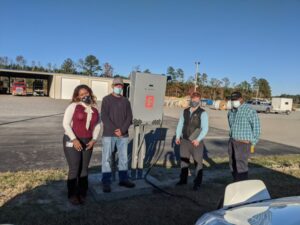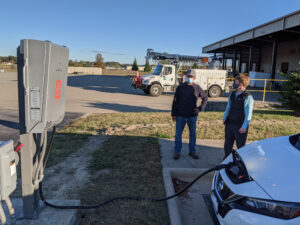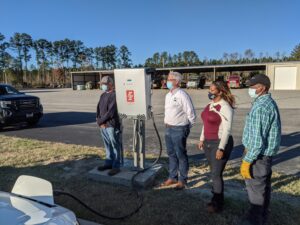NC Cooperative Demonstration of Vehicle-to-Grid Smart Charger Shows Economic Value
 Electric vehicles (EVs) have the potential to be more than just a means of transportation now that more automakers are selling vehicles compatible with vehicle-to-grid technology, like Nissan LEAF, Ford F150 Lightning, and the Thomas Built C2 Jouley school bus. Bidirectional capable charging stations can transform electric cars, buses, garbage trucks, fleet vehicles and more into mobile energy storage banks.
Electric vehicles (EVs) have the potential to be more than just a means of transportation now that more automakers are selling vehicles compatible with vehicle-to-grid technology, like Nissan LEAF, Ford F150 Lightning, and the Thomas Built C2 Jouley school bus. Bidirectional capable charging stations can transform electric cars, buses, garbage trucks, fleet vehicles and more into mobile energy storage banks.
Preliminary findings from a demonstration of two-way, vehicle-to-grid (V2G) technology in North Carolina show the economic potential for using bidirectional charging technologies to feed energy stored in electric vehicle batteries back to charging sites, especially when the grid is experiencing high demand.
 The NC Clean Energy Technology Center (NCCETC) is coordinating with Roanoke Electric Cooperative (REC) to demonstrate and evaluate the economic case for the use of a two-way charger made by Fermata Energy, maker of the first EV charger certified for the North American standard for bidirectional charging. The project also benefits from support from partners including Advanced Energy, Clean Energy Works, and Environmental Defense Fund.
The NC Clean Energy Technology Center (NCCETC) is coordinating with Roanoke Electric Cooperative (REC) to demonstrate and evaluate the economic case for the use of a two-way charger made by Fermata Energy, maker of the first EV charger certified for the North American standard for bidirectional charging. The project also benefits from support from partners including Advanced Energy, Clean Energy Works, and Environmental Defense Fund.
REC’s headquarters in the rural town of Ahoskie, NC, is the demonstration site for the project, where technicians for the utility’s growing broadband business use the utility’s two Nissan LEAF electric vehicles. The cooperative provides electricity and broadband services to a wide variety of industrial, recreational, educational, community and other interests in addition to farms in northeast North Carolina.
The two-way “smart” charger provides power to Roanoke Electric’s two EV cars, and it is one of the first chargers delivered from Fermata’s manufacturing site in Danville, Virginia. This charger not only curtails a vehicle’s charging in response to peak system demand, but also, it can discharge the energy stored in a connected EV to meet some of the demand at the site when demand on the grid is high.
The V2G charging technology was thoroughly tested by Underwriters Laboratory to meet the North American standard for bidirectional charging. The purpose of this current demonstration has been to illuminate the value potential of V2G for fleet managers, energy professionals and utility companies— and the project is well on its way to accomplishing that goal.
Initial Results
A common question from fleet managers is, “how can I be sure the vehicle will be fully charged when I need it?” In summary, the intelligence of the bidirectional system’s software enables it to be programmed to meet the fleet owners’ needs.
When the V2G system is responding to system-wide peak demand events, they are scheduled in advance, so a fleet manager can choose to reserve the vehicle for the grid (or the building) at that time as if it were reserved for another driver, while simply leaving the vehicle plugged in. The impetus for this decision is knowing how much it would be worth to leave the vehicle plugged-in for grid operations at that time. After the bidirectional event, the system allows scheduled recharging to be programmed in a way that meets the fleet operator’s needs while providing transparency about the monetary value the vehicle can provide at different times for grid operations.
Fermata Energy’s FE-15 is capable of providing 15 kilowatts of power both to the car and back to the site served by the grid. REC schedules dispatch of the on-board battery in response to predicted peaks, which usually lasts two to three hours. Using only one of REC’s Nissan LEAFs, the V2G system has been able to reduce the utility’s load, on average, by 14.14 kW during the entirety of the 85 event hours to date, across a variety of operating conditions.
As an example, during a window of recent events, the two-way EV charger discharged the EV battery at 14 kW on average, and it saved the cooperative nearly $440.
The results from this small window suggest savings of over $2,660 a year per two-way charger. The value of this single unit hints at the potential for much bigger savings when multiplied by many units, serving multiple EVs or integrated with entire fleets of EVs. While some chargers may not have an EV connected during every peak period, utilities will develop experience over time with a minimum fraction of availability across thousands of EVs and two-way charging stations, accessing hundreds of MWh of energy storage on-board local EVs.
In addition to system-wide savings, V2G chargers can also create savings for non-residential customers that pay demand charges. Despite having relatively modest demand charges of $9.50/kW, Fermata’s software and charger strategically dispatched the Nissan LEAF battery to reduce REC’s headquarters building demand charges by $234 over a two month period. At larger facilities, Fermata has demonstrated the FE-15 is capable of capturing the full 15 kW in savings possible, and in parts of the country where demand charges can surpass $20/kW, customers could realize savings of over $300 a month.
For REC and its members, and any utility with demand charge and demand response programs in which V2X technology can participate, the benefits of system-wide savings as well as customer savings can be realized simultaneously. Using REC’s local and system demand charges, each FE-15 operating at maximum capacity could result in $3,500 to $4,000 of savings each year.
 Roanoke Electric has also been able to demonstrate another application that V2X technology makes possible for improving energy assurance and reliability. REC’s facility has an on-site generator that allows it to isolate itself from the grid, and Fermata’s V2X charger can discharge the Nissan LEAF battery to partially power the facility either by dispatching stored energy when the site’s usage is highest, or by reacting to scheduled discharges for a set duration. The ability for smart charging to respond to an islanded load powered by the generator increases the resilience of sites that use generators as back-up power systems.
Roanoke Electric has also been able to demonstrate another application that V2X technology makes possible for improving energy assurance and reliability. REC’s facility has an on-site generator that allows it to isolate itself from the grid, and Fermata’s V2X charger can discharge the Nissan LEAF battery to partially power the facility either by dispatching stored energy when the site’s usage is highest, or by reacting to scheduled discharges for a set duration. The ability for smart charging to respond to an islanded load powered by the generator increases the resilience of sites that use generators as back-up power systems.
These results have important implications for the affordability of electricity, both for grid operators and for the member owners of the electric cooperative. REC’s CEO Curtis Wynn has underscored the improvements to grid utilization that the utility can attain when distributed storage is available to member-owners on the Roanoke Electric grid.
The Potential of Vehicle-to-Grid Technology
 As public and private fleets in the United States replace internal-combustion engine vehicles with EVs, integration of V2G technology could enable EVs to serve as energy reservoirs to help keep the grid running smoothly during demand peaks and during system outages.
As public and private fleets in the United States replace internal-combustion engine vehicles with EVs, integration of V2G technology could enable EVs to serve as energy reservoirs to help keep the grid running smoothly during demand peaks and during system outages.
In this demonstration at REC, the dollar savings appear to nearly offset the cost of the EVs. The cooperative’s two new Nissan LEAFs with 62kWh battery capacities are leased at less than $250 per month, and the demonstration has documented a generated value of as high as $230 a month. The implications for dropping the net cost of electric mobility to Roanoke Electric member-owners is tremendous.
On a residential scale, electric vehicle drivers could use vehicle-to-building technology to power their homes during lengthy blackouts. With a bidirectional charging system, homeowners could pull power from their electric vehicle batteries to keep fridges, lights, the internet and heating and cooling systems on in their homes, especially when jeopardized by heat waves or hypothermia as seen this year in Texas.
Vehicle-to-building technology could also keep the power on for critical services such as hospitals and shelters during extreme weather conditions and other emergency outages, reducing or even eliminating the cumulative numbers of hours these essential systems have to use backup diesel generators.
As the demonstration continues, REC staff are exploring a pilot application of the technology with commercial customers, focusing first on locations having higher voltage service — in line with the design of the FE-15 device.
John Bonitz, a specialist for NCCETC’s Clean Transportation Program, said, “Preparing for a future where fleets of electric buses and cars will be electrified, this demonstration at Roanoke Electric Cooperative is helping prove the benefits and economic value of integrating V2G technology to shave peaks, improve grid utilization and increase resilience – all while helping the cooperative and its members save money. And we’re honored to be involved.”
ABOUT THE TEAM
This demonstration is possible only due to a unique partnership between six organizations: Roanoke Electric Cooperative serves about 14,000 accounts in Northeastern North Carolina out of their headquarters in Ahoskie, NC. Fermata Energy is a company created for the dual purposes of accelerating the adoption of EVs and accelerating the transition to a renewable energy future, and it is their bi-directional EV charger and proprietary software system that allow electric vehicles to earn money while they are parked. Clean Energy Works provides advisory services for accelerating investment in grid-edge solutions. Advanced Energy is a nonprofit energy consulting firm that assists utilities with program design and electric transportation initiatives. Environmental Defense Fund, a leading international nonprofit organization, creates transformational solutions to the most serious environmental problems, including supporting policies that accelerate transportation electrification to create a zero-emission future. The NCCETC’s Clean Transportation Program is supporting the demonstration with analysis, technical assistance and facilitation. NCCETC also hosts the largest outreach and engagement events in the region on sustainable fleets, the Sustainable Fleet Technology virtual conference series.